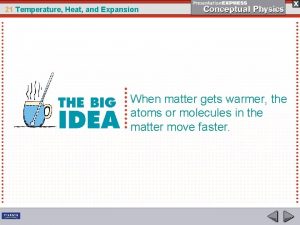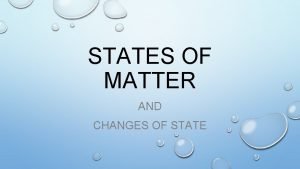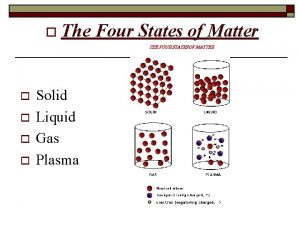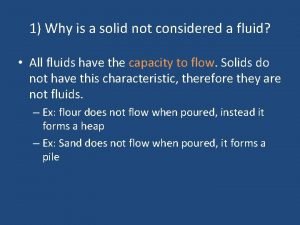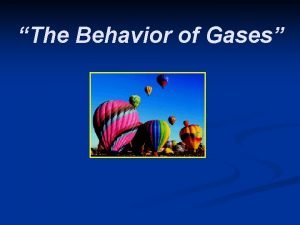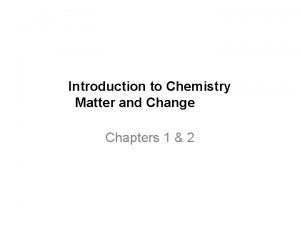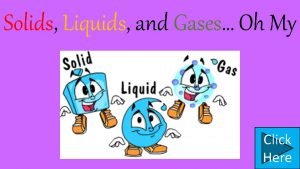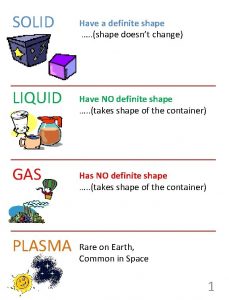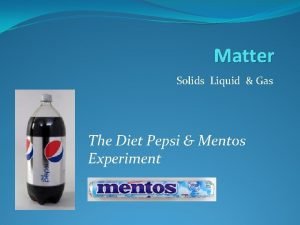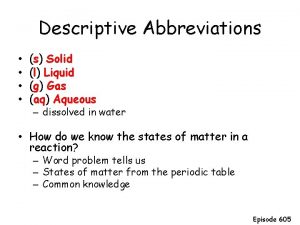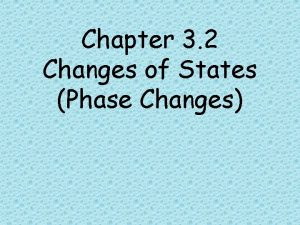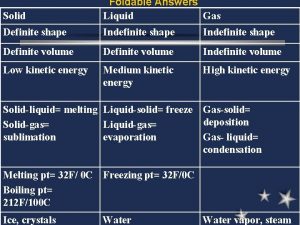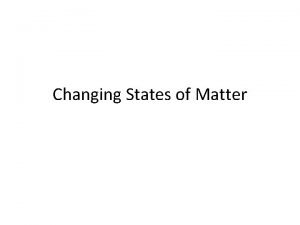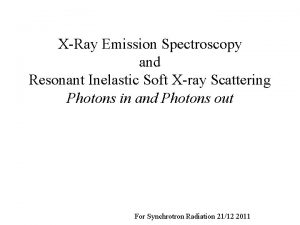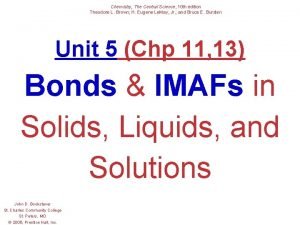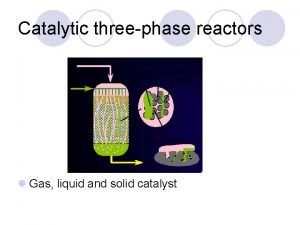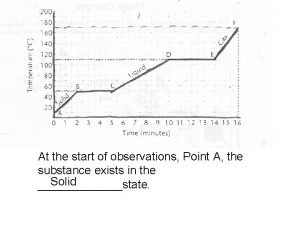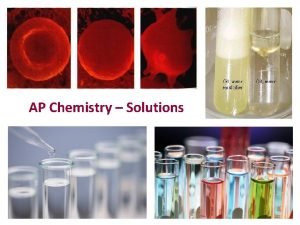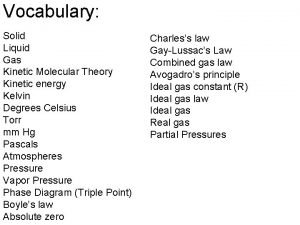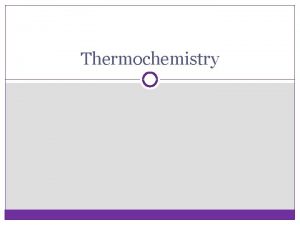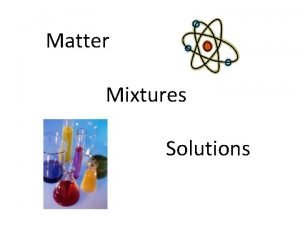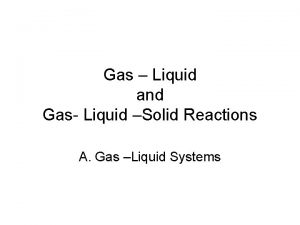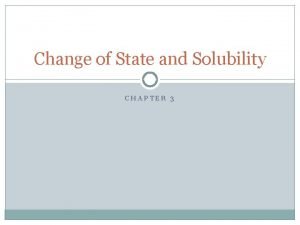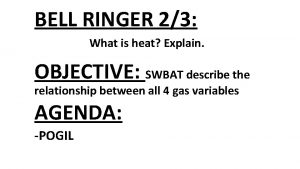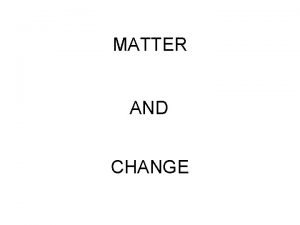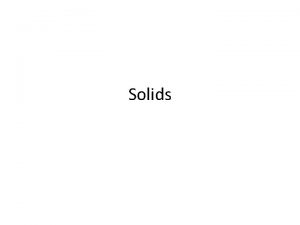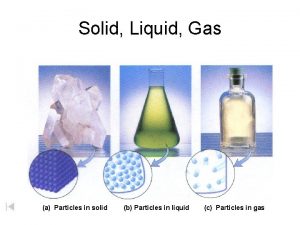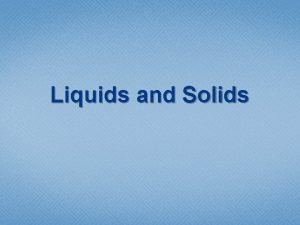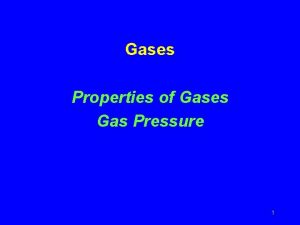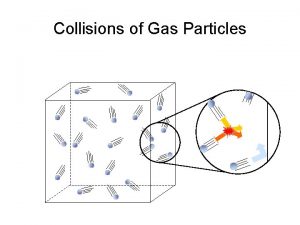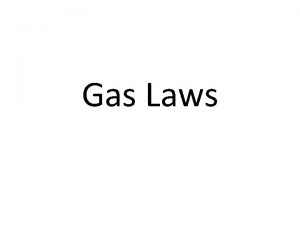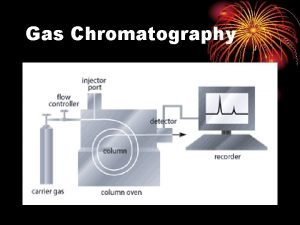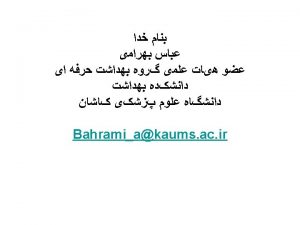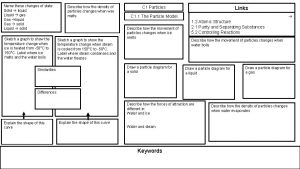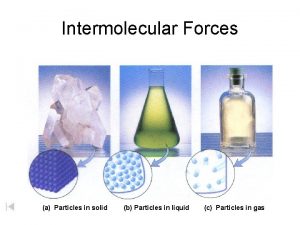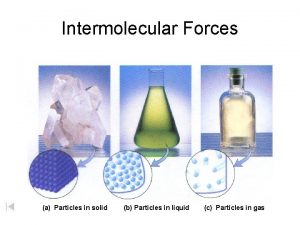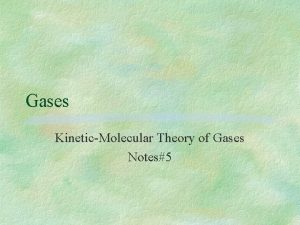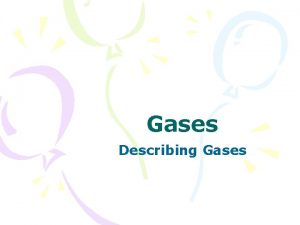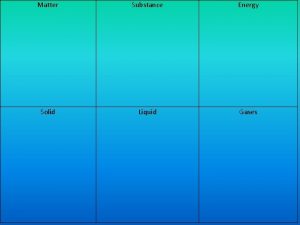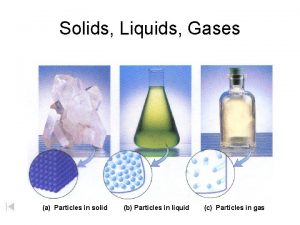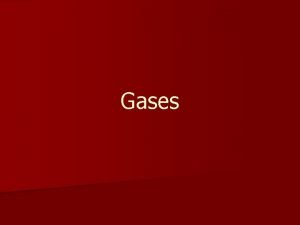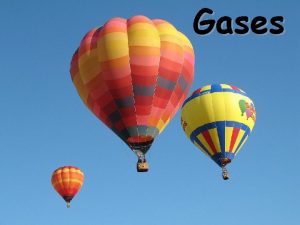Gases Particles in a Solid Liquid and Gas







































- Slides: 39

Gases

Particles in a Solid, Liquid and Gas

Random Motion of Gas Particles

II. Gas Pressure A. Pressure is force per unit area (f/a) 1. result of particle collisions 2. measured by a barometer 3. influenced by temperature, gas volume, and the number of gas particles a. as the number of particle collisions increases the pressure increases

Pressure at Sea Level 14. 7 psi = 1. 0 atm = 760 mm of Hg = 750 Torr = 101. 3 k. Pa = 1, 013 mbars

I. Kinetic Theory A. Assumptions 1. gas particles do not attract each other 2. gas particles are very small 3. particles are very far apart 4. constant, random motion 5. elastic collisions 6. kinetic energy varies with temperature

B. Properties of Gases 1. low density (grams/liter) 2. can expand can be compressed 3. can diffuse and effuse a. rate related to molar mass b. diffusion is the movement of particles from an area of greater concentration to an area of lesser concentration c. effusion is the movement of gas particles through a small opening

Measuring Atmospheric Pressure

Aneroid Baramoter Mercury Barometer

II. The Gas Laws A. Boyle’s Law (P 1 V 1 = P 2 V 2 )inverse relationship 1. As the volume of a gas increases the pressure decreases (temperature remains constant) 2. Example A sample of gas in a balloon is compressed from 7. 00 L to 3. 50 L. The pressure at 7. 00 L is 125 KPa. What will the pressure be at 2. 50 L if the temperature remains constant? P 1 = 125 KPa P 2 = X V 1 = 7. 00 L V 2 = 3. 50 L (125)(7. 00) = (X) (3. 50) X = 250. KPa

Boyle’s Law

As volume increases the pressure decreases when temperature remains constant

Boyles Law

Boyle’s Law • Pressure is related to 1/Volume Slope (k) = relationship between P and 1/V P = k(1/V)

B. Charles’ Law V 1 = V 2 must use kelvin T 1 T 2 temperature 1. As the temperature of a gas increases the volume increases (direct relationship) 2. Example A gas sample at 20. 0 C occupies a volume of 3. 00 L. If the temperature is raised to 50. 0 C, what will the volume be if the pressure remains constant? V 1 = 3. 00 L V 2 = X T 1 = 293 K T 2 = 323 K 3. 00 = X 293 X = (3)(323) 293 323 293 X = 3. 31 L

Charles’ Law – Temperature increases – volume increases

Charles’ Law

C. Gay Lussac’s Law P 1 = P 2 T 1 T 2 1. as the temperature increases the pressure increases when the volume remains constant 2. Example The pressure of a gas in a tank is 4. 00 atm at 200. 0 C. If the temperature rises to 800. 0 C, what will be the pressure of the gas in the tank? P 1 = 4. 00 atm P 2 = X T 1 = 473 K T 2 = 553 K 4. 00 = X 473 X = (4)(553) 473 553 473 X = 4. 68 atm

D. Combined Gas Law P 1 V 1 = P 2 V 2 T 1 T 2 1. Combines Boyle’s, Charle’s and Gay Lussac’s 2. Example A gas at 70. 0 KPa and 10. 0 C fills a flexible container with an initial volume of 4. 00 L If the temperature is raised to 60 C and the pressure is raised to 80. 0 KPa, what is the new volume? P 1 = 70. 0 KPa P 2 = 80. 0 KPa V 1 = 4. 00 V 2 = X T 1 = 283 K T 2 = 333 K (70. 0)(4. 00) = (80. 0)(X) 283 333 X = (33. 3)(70. 0)(4. 00) (2. 83)(80. 0) X = 41. 2 L

E. Dalton’s Law of Partial Pressures Ptotal = P 1 + P 2 + P 3 +. . . Pn The total pressure of a mixture of gases is equal to the sum of the pressures of all the gases in the mixture 1. Example Find the total pressure for a mixture that contains four gases with partial pressures of 5. 00 k. Pa, 4. 56 k. Pa, 3. 02 k. Pa and 1. 20 k. Pa.

Dalton’s Law Partial Pressures

Dalton’s Law of Partial Pressures

2. Suppose two gases in a container have a total pressure of 1. 20 atm. What is the pressure of gas B if the partial pressure of gas A is 0. 75 atm? 3. What is the partial pressure of hydrogen gas in a mixture of hydrogen and helium if the total pressure is 600. 0 mm. Hg and the partial pressure of helium is 439 mm. Hg?

III. Avogadro’s Principle A. Equal volumes of gases at the same temperature and pressure have the same number of particles B. Molar Volume (22. 4 L at STP) 1. volume of one mole of gas particles at STP(standard temperature and pressure) 0 C and 1. 00 atm (760 mm Hg) * 1 mole of any gas at STP = 22. 4 L 2. conversion factors 1 mol 22. 4 L 1 mol

Avogadro’s Principle

Equal volumes of gases at the same temperature and pressure contain the same number of particles

C. Sample Problems 1. Calculate the volume occupied by. 250 mol of oxygen gas at STP. 2. Calculate the number of moles of methane gas in a 11. 2 L flask at STP.

3. Calculate the volume of 88. 0 g of CO 2 at STP. 4. How many grams of He are found in a 5. 60 L balloon at STP?

5. Calculate the density of H 2 at STP. D = molar mass molar volume 6. Calculate the molar mass of a gas that has a density of 3. 2 g/L.

IV. Ideal vs Real Gases A. Ideal compared to Real Gases 1. ideal gas a) particles do not have volume b) there are no intermolecular attractions c) all particle collisions are elastic d) obey all kinetic theory assumptions

2. real gases behave like ideal gases except when a) pressure is very high b) temperatures are low c) molecules are very large d) spaces between particles is small (small volume)

B. Ideal Gas Law - PV = n. RT 1. pressure ( atm, mm Hg, KPa) 2. volume (liters) 3. temperature (kelvin) 4. number of moles (n) 5. R = constant (L) (pressure unit*) (mol) (K)

• unit for pressure determines which constant must be used in the Ideal Gas Law PV = n. RT a) R = 62. 4 (pressure is mm Hg) b) R =. 0821 (pressure is atm) c) R = 8. 314 (pressure is KPa)

Ideal Gas Law PV = n. RT

What Principles and/or Laws are Ilustrated?

C. Application Problems (PV = n. RT) 1. How many moles of O 2 are in a 2. 00 L container at 2. 00 atm pressure and 200 K? 2. Calculate the volume occupied by 2. 00 mol of N 2 at 300 K and. 800 atm pressure.

3. What is the pressure in mm Hg of. 200 moles of gas in a 5. 00 L container at 27 C? 4. Calculate the number of grams of oxygen in a 4. 00 L sample of gas at 1. 00 atm and 27 C.

V. Gas Stoichiometry A. Coefficients and Gas Volume 1. Gay Lussac’s Law of Combining Volumes a) gases in chemical reactions react with each other in whole number ratios at a constant temperature and pressure CH 4 + 2 O 2 -----> CO 2 + 2 H 2 O 1 volume 2 volumes 1 mole 2 moles 22. 4 L 2 x 22. 4 L

Law of Combining Volumes
 Solid
Solid Mass of solid liquid and gas
Mass of solid liquid and gas Solid liquid gas particles
Solid liquid gas particles Chapter 21: temperature, heat, and expansion answer key
Chapter 21: temperature, heat, and expansion answer key Solid liquid and gases
Solid liquid and gases Venn diagram of solid liquid gas
Venn diagram of solid liquid gas Plasma particle arrangement
Plasma particle arrangement Process of liquid to gas
Process of liquid to gas Solid particles
Solid particles Why is gas easier to compress than a liquid or a solid
Why is gas easier to compress than a liquid or a solid Why are liquids incompressible
Why are liquids incompressible Are ideal gases compressible
Are ideal gases compressible Mass of solid liquid and gas
Mass of solid liquid and gas Liquid information
Liquid information Matter concept map
Matter concept map Examples of liquids
Examples of liquids Definite volume
Definite volume What state of matter is pepsi
What state of matter is pepsi Solid liquid, gas aqueous chart
Solid liquid, gas aqueous chart Solid liquid gas
Solid liquid gas Solid definite or indefinite
Solid definite or indefinite Properties of matter graphic organizer
Properties of matter graphic organizer Matter and energy concept map
Matter and energy concept map Gas liquid solid
Gas liquid solid The higher the amplitude, the _______the sound.
The higher the amplitude, the _______the sound. Solid liquid gas difference
Solid liquid gas difference Gas liquid solid
Gas liquid solid Gas liquid solid
Gas liquid solid Gas liquid solid
Gas liquid solid Solid gas liquid
Solid gas liquid Solid liquid gas
Solid liquid gas States of matter solid liquid gas
States of matter solid liquid gas Two film theory
Two film theory Solid liquid gas
Solid liquid gas Liquid solid gas
Liquid solid gas Chemistry
Chemistry Volume solid liquid gas
Volume solid liquid gas Motion of particles in solids, liquids and gases
Motion of particles in solids, liquids and gases Definite arrangement
Definite arrangement Spaces between particles of liquid
Spaces between particles of liquid



